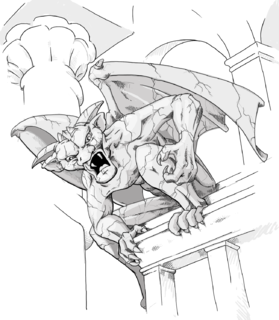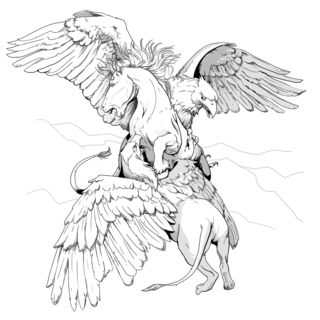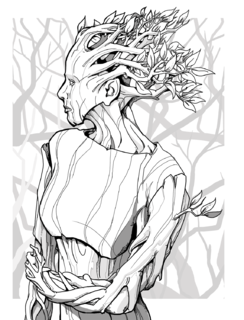| Basilisk | |
|---|---|
 |
Many fantasy roleplaying games have included a version of the mythological basilisk among the creatures that the players may encounter. The creatures are frequently lizard-like with the ability to turn characters to stone. [1]

Fantasy is a genre of speculative fiction set in a fictional universe, often inspired by real world myth and folklore. Its roots are in oral traditions, which then became literature and drama. From the twentieth century it has expanded further into various media, including film, television, graphic novels, manga and video games.
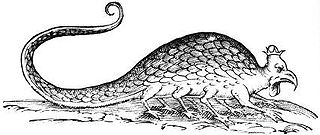
In European bestiaries and legends, a basilisk is a legendary reptile reputed to be a serpent king, who can cause death with a single glance. According to the Naturalis Historia of Pliny the Elder, the basilisk of Cyrene is a small snake, "being not more than twelve fingers in length", that is so venomous, it leaves a wide trail of deadly venom in its wake, and its gaze is likewise lethal. Its weakness is the odor of the weasel, which, according to Pliny, was thrown into the basilisk's hole, recognizable because some of the surrounding shrubs and grass had been scorched by its presence. It is possible that the legend of the basilisk and its association with the weasel in Europe was inspired by accounts of certain species of Asiatic snakes and their natural predator, the mongoose.
Basilisks and variations of the monster have appeared in every edition of the Dungeons & Dragons franchise. [2] [ non-primary source needed ] Within Dungeons & Dragons, the basilisk is depicted a giant lizard with eight legs, [3] and as a reptilian monster whose gaze can turn creatures to stone. [1] The basilisk received detailed coverage in Dragon #81 (January 1984), in "The Ecology of the Basilisk," by Ed Greenwood. [4] A figurine of the basilisk was included in the D&D Miniatures: Giants of Legend set #13 which was released in 2004.

Dungeons & Dragons is a fantasy tabletop role-playing game (RPG) originally designed by Gary Gygax and Dave Arneson. It was first published in 1974 by Tactical Studies Rules, Inc. (TSR). The game has been published by Wizards of the Coast since 1997. It was derived from miniature wargames, with a variation of the 1971 game Chainmail serving as the initial rule system. D&D's publication is commonly recognized as the beginning of modern role-playing games and the role-playing game industry.

Ed Greenwood is a Canadian fantasy writer and the original creator of the Forgotten Realms game world. He began writing articles about the Forgotten Realms for Dragon magazine beginning in 1979, and subsequently sold the rights to the setting to TSR, the creators of the Dungeons & Dragons roleplaying game, in 1986. He has written many Forgotten Realms novels, as well as numerous articles and D&D game supplement books.
The basilisk has also appeared in d20 System games by Necromancer Games in their Tome of Horrors sourcebook [5] [ non-primary source needed ] and Paizo Publishing's Pathfinder Roleplaying Game Bestiary [6] [ non-primary source needed ].
The d20 System is a role-playing game system published in 2000 by Wizards of the Coast, originally developed for the third edition of Dungeons & Dragons. The system is named after the 20-sided dice which are central to the core mechanics of many actions in the game.

Necromancer Games was an American publisher of role-playing games. With offices in Seattle, Washington and Coeur d'Alene, Idaho, the company specialized in material for the d20 System. Most of its products were released under the Open Game License of Wizards of the Coast.
Paizo Publishing is an American publishing company in Redmond, Washington that specializes in game aids and adventures for "the world's oldest fantasy roleplaying game" and its flagship spin-off game and setting, Pathfinder. The company's name is derived from the Greek word παίζω paizō, which means 'I play' or 'to play', and in 2014, the company changed its name to Paizo Inc. Paizo also runs an online retail store selling role-playing games, gaming aids, board games, comic books, toys, clothing and other products, and has an Internet forum community. The current CEO of Paizo is Lisa Stevens.
In the Harry Potter and the Chamber of Secrets video game, the player, as Harry, encounters the basilisk in a climactic battle before the last cut scene of the game. During the battle, Harry fights with a sword rather than with the wand the character has used through the previous portions of the game. The basilisk is represented as spitting poison which hurts the character. [7]
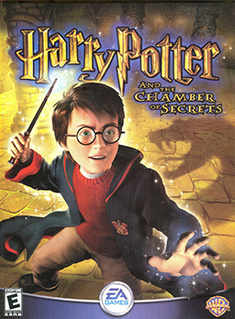
Harry Potter and the Chamber of Secrets is an action-adventure video game published by Electronic Arts based on J.K. Rowling's novel Harry Potter and the Chamber of Secrets and the film of the same name. It was the second to last game released for the Game Boy Color in North America. and also the last Harry Potter game to be released on the PlayStation.

Harry Potter is the titular protagonist of J. K. Rowling's Harry Potter series. The majority of the books' plot covers seven years in the life of the orphan Potter, who, on his eleventh birthday, learns he is a wizard. Thus, he attends Hogwarts School of Witchcraft and Wizardry to practice magic under the guidance of the kindly headmaster Albus Dumbledore and other school professors along with his best friends Ron Weasley and Hermione Granger. Harry also discovers that he is already famous throughout the novel's magical community, and that his fate is tied with that of Lord Voldemort - the internationally feared Dark Wizard and murderer of his parents, Lily and James. The film and book series revolve around Harry's struggle to adapt to the wizarding world and defeat Voldemort. Harry is considered a fictional icon and has been described by many critics, readers, and audiences as one of the greatest literary and film characters of all time.
In the MMORPG EverQuest, the basilisks have a stone breath attack. [8] [ non-primary source needed ]

EverQuest is a 3D fantasy-themed massively multiplayer online role-playing game (MMORPG) originally developed by Verant Interactive and 989 Studios for Windows PCs. It was released by Sony Online Entertainment in March 1999 in North America, and by Ubisoft in Europe in April 2000. A dedicated version for macOS was released in June 2003, which operated for ten years before being shut down in November 2013. In June 2000, Verant Interactive was absorbed into Sony Online Entertainment, who took over full development and publishing duties of the title. Later, in February 2015, SOE's parent corporation, Sony Computer Entertainment, sold the studio to investment company Inception Acquisitions and was rebranded as Daybreak Game Company, who develops and publishes EverQuest to this day.
In its strategy guide for the computer game Heroes of Might and Magic III , GameSpot describes the basilisks the "saving grace" of the Fortress castle type, as they are a "surprisingly effective" unit for the mid-game being "good in speed, offense, defense, and hit points" with a petrification power and the ability to be upgraded to "Greater Basilisk". [9]

Heroes of Might and Magic III: The Restoration of Erathia is a turn-based strategy game developed by Jon Van Caneghem through New World Computing originally released for Microsoft Windows by the 3DO Company in 1999. Its ports to several computer and console systems followed in 1999-2000. It is the third installment of the Heroes of Might and Magic series. The game's story is first referenced throughout Might and Magic VI: The Mandate of Heaven and serves as a prequel to Might and Magic VII: For Blood and Honor. The player can choose to play through seven different campaigns telling the story, or play in a scenario against computer or human opponents.




